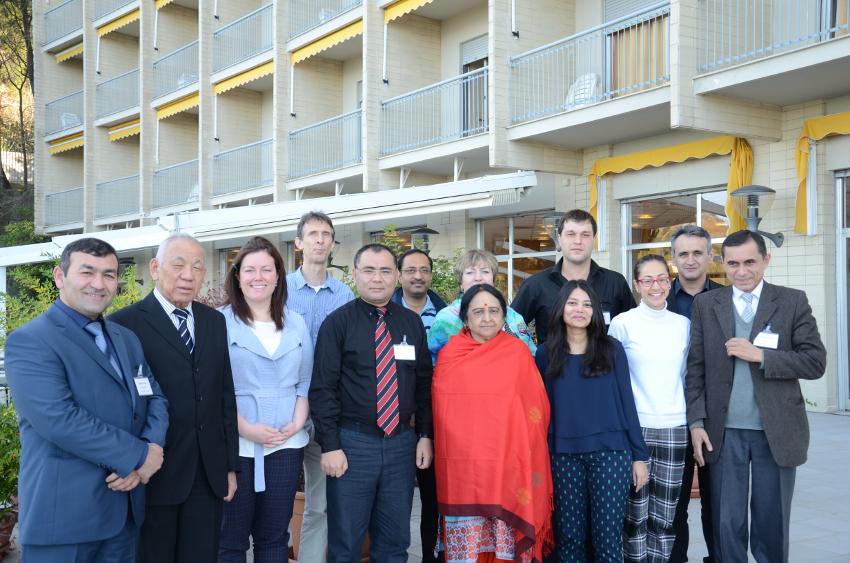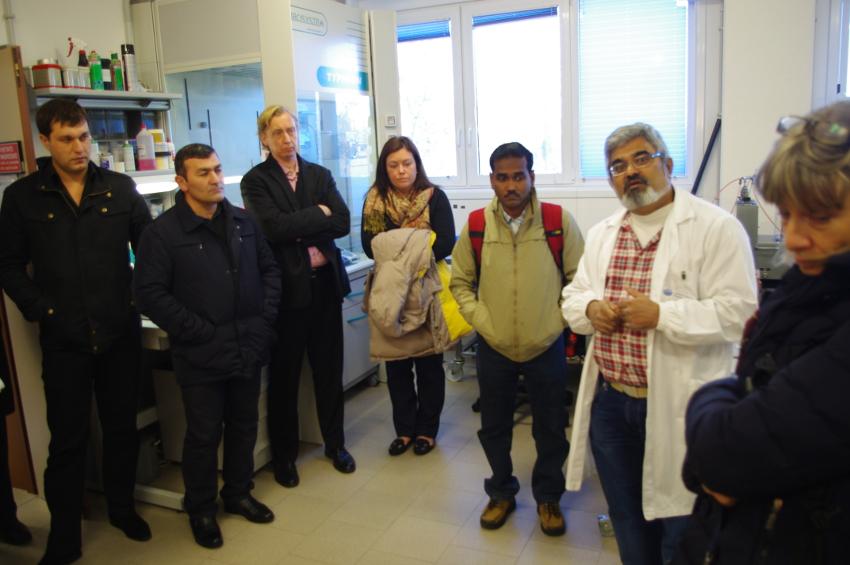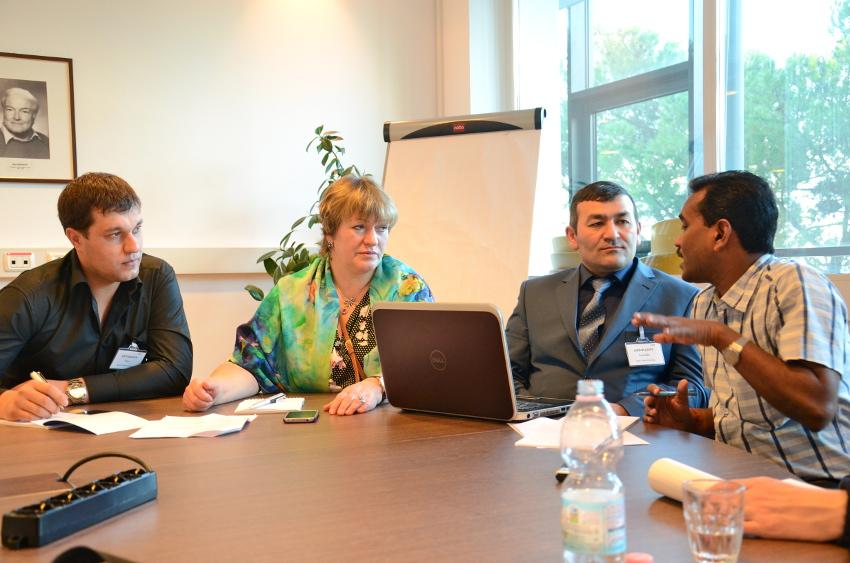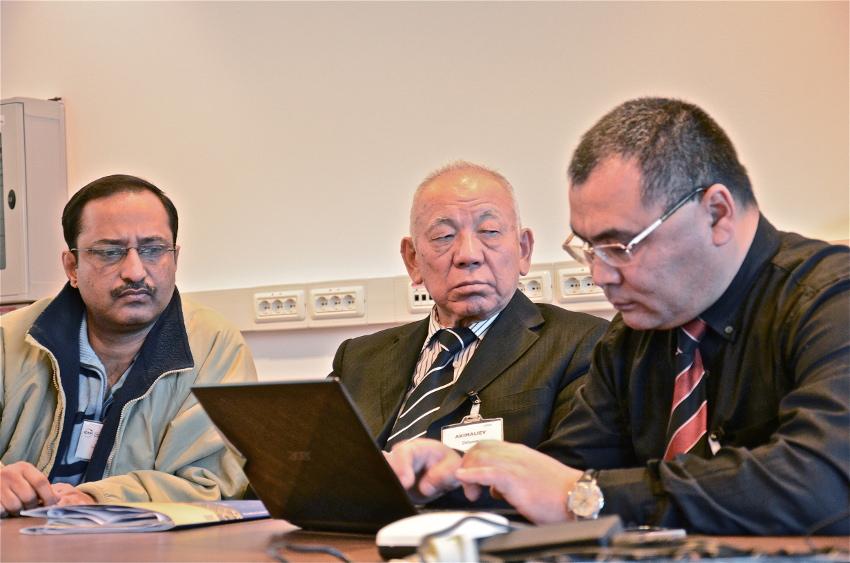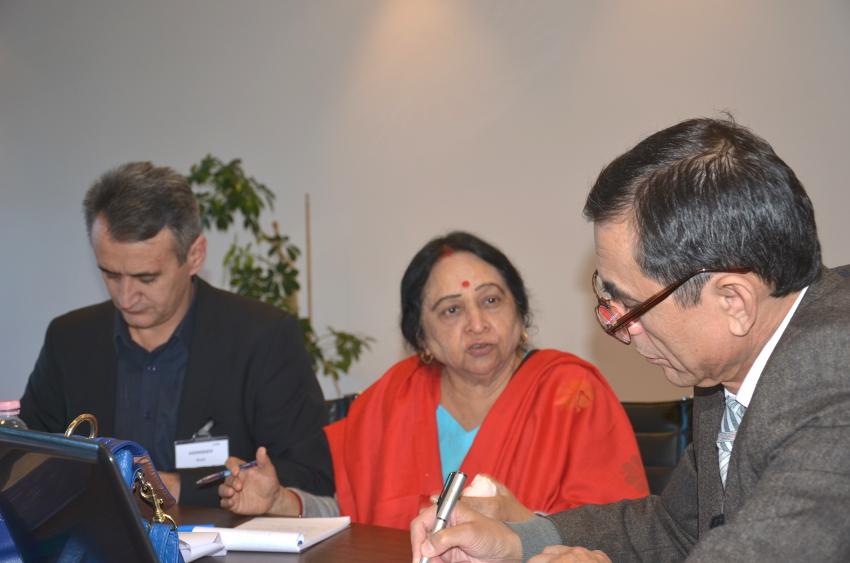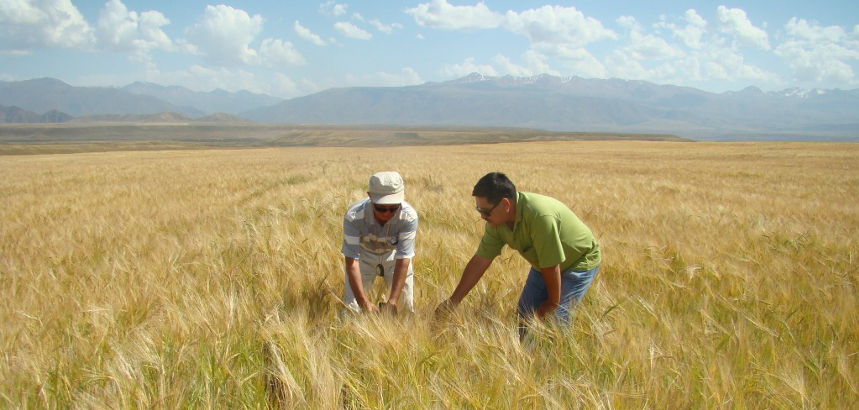
In Central Asia, where the livelihoods of almost half the region's population depend on agriculture from irrigated lands, climate change presents a grave threat. Days are getting hotter, nights are getting cooler, and rising temperatures are causing the essential source of the region’s water – high mountain glaciers – to melt away.
Dzhamin Akimaliev, the director of Kyrgyzstan’s Scientific Research Institute of Agriculture, said the temperature in his country has risen 1.6 degrees Celsius in the past 100 years. Meanwhile, the melting glaciers atop his country’s Tien-Shan mountains are shrinking, causing more agriculture-feeding water to flow. That increase will last for 15 to 20 years, he said, but once the glaciers disappear, so will the water.
“For more than 10 years I have been saying that mountain-area research is important for our country,” he said, “because the future of agriculture is in the mountain area. We have to be ready on this.”
So how can the five former Soviet states there, which are already competing for existing water resources, with help from India, find ways to work together and address this common challenge?
This is what Akimaliev and six other representatives of four Central Asian countries sought to answer at a recent TWAS science diplomacy workshop in Trieste, Italy. The workshop, "Climate Change and a Global Research Agenda for High-Altitude Agriculture in Central Asia and India”, was attended by scientists from Kazakhstan, Uzbekistan, Kyrgyzstan and Tajikistan. Running from 9 to 11 December in Trieste, Italy, it had 17 participants in all and included scientists and policy experts from India – which has experience dealing with similar climate issues – Italy and the United States.
It was the latest event under an agreement between the American Association for the Advancement of Science (AAAS) and TWAS that created a science diplomacy programme focused on developing nations. The workshop was organized by Peter McGrath and Sara Dalafi, who coordinate TWAS's science and diplomacy initiative. McGrath said the workshop accomplished a key aim: Encouraging countries to work together on common issues that cross international borders.
At the workshop, science served as a bridge between countries don't always agree on how to best use natural resources. But it also presented a starting point for collaborative thinking on an environmental issue that is already putting pressure on their farmlands and their people. After all, in Central Asia, every country has a clear thing in common: They are all downstream.
A pressing demand for water
 Agriculture in all of the Central Asian countries is fed by water that flows down from mountain ranges that are concentrated in the eastern countries of Kyrgyzstan and Tajikistan.
Agriculture in all of the Central Asian countries is fed by water that flows down from mountain ranges that are concentrated in the eastern countries of Kyrgyzstan and Tajikistan.
In Tajikistan, one of the two most mountainous countries in the region, the ice atop the Pamir-Alai mountains is already fading away. Kazakhstan, the largest of the Central Asian countries, has mountains in two ranges, and its warm climates are home to forested terrains that are gradually ascending up the mountainsides. Since 1991, Kazakhstan's mountain rivers are flooding about twice as often as before.
Meanwhile, all five Central Asian nations are using water at an intense pace, mostly to support crops in soils that aren't ideal for agriculture. Turkmenistan uses more water per capita than any other nation in the world, according to a Nature report on World Bank figures. The other Central Asian nations are not far behind: Uzbekistan is fourth, Kyrgyzstan is fifth, Tajikistan is seventh and Kazakhstan is 11th. This leads to conflicts between the states in the region as they compete for crop water.
One example of a crop fed by this water supply is cotton in Uzbekistan, which is mainly a desert country, and uses irrigation systems to feed its cotton fields in the mountain plains. As the water source declines, however, the country is concerned that agriculture may drop by as much as 30-50%, said workshop attendee Ibrokhim Abdurakhmonov, director of the Center of Genomics and Bioinformatics of the Academy of Sciences of Uzbekistan. He is also a TWAS Fellow and won a TWAS Prize in 2010 for his molecular biology work on cotton crops.
Uzbekistan is also concerned about the more extreme day and night temperatures, which cause a drop in cotton yields. So researchers there are exploring ways to make their cotton crops more resilient using biotechnology. "If you have better adapted plants for agriculture, even at high altitudes, you will get good crops," said Abdurakhmonov.
Central Asia's dependence on agriculture is also a pressing issue, as each country is also trying to stabilize their footing in the global economy. The Soviet Union used these lands for what they could produce for a large, sprawling super-power. Now that they are separate nations, each country has to produce the goods needed to sustain itself. Change for the young nations has been difficult so far – but all the more reason to find common bonds to unite their interests.
Cristine Geers, a program associate of the AAAS International Office, described the workshop as a bottom-up approach to helping these countries overcome some of their geopolitical obstacles.
“It’s the only way of really linking these institutions and some of them are doing the same work. Some of them could be doing collaborative research very easily,” she said. “This workshop was really like a first step to use science as a platform to more strongly link the collaboration on an issue of common importance, which is climate change, because it does affect them all.”
Even the farmland giant of the region, Kazakhstan, is facing its share of threats. Workshop attendee Svetlana Dolgikh, head of the Kazakhstan Division of Climate Research, said less rain in the summer will lead to lower agricultural yields, and higher temperatures will mean more stress on livestock. They will need water-saving technologies, such as small dams to collect meltwater and the reconstruction of old irrigation systems, to keep their agricultural systems healthy.
“Is there any evidence of a reduction of agricultural production so far?” asked Abdurakhmonov, of Uzbekistan.
“Yes,” Dolgikh answered. “Many regions have had droughts, which are the main reason for the reduction in agricultural yields. Every two years we have had droughts in big regions of Kazakhstan, for the last ten years.”
Ideas for a united effort
 As the climate changes, researchers will need to gather information, store it in databases, and share it among colleagues and policymakers. To some degree, systems to manage this information already exist in each of the countries, said Kamolidin Abdulloev, a consultant for Tajikistan’s Pilot Program for Climate Resilience. What’s needed, he said, is a regional system, especially since some important fields such as biotechnology and bioengineering are new for some Central Asian countries.
As the climate changes, researchers will need to gather information, store it in databases, and share it among colleagues and policymakers. To some degree, systems to manage this information already exist in each of the countries, said Kamolidin Abdulloev, a consultant for Tajikistan’s Pilot Program for Climate Resilience. What’s needed, he said, is a regional system, especially since some important fields such as biotechnology and bioengineering are new for some Central Asian countries.
“We need to have a very good coordination mechanism for these activities,” said Abdulloev. “As it is now, when I am looking for expertise on farmed goods from Uzbekistan or maybe from India or from other countries, or if I need some information about new agricultural practices or climate-resilient crop, the information is not accessible.”
Manju Sharma, distinguished woman scientist chair of the National Academy of Sciences, India, former secretary of India's Department of Biotechnology and a TWAS Fellow, said that kind of regional network needs coordination on two levels. One is the institutional level, so that experts can monitor the data and disseminate it to farmers. The other, more important level, is through field work – such as knowledge centres established in India that have been successfully getting important climate information to rural populations that speak regional dialects.
“There you can use the mobile services, or even, in the local language, disseminate information,” said Sharma. “So monitoring infrastructure has to be created at the field level through site visits to monitor what the farmer is getting, how much advantage he’s getting, and what is the benefit or disadvantage.”
Participants also concluded that they should write a “white paper” – a document that outlines research strategies and policy recommendations that can be formally published in a journal and available to decision-makers. Researchers from each country in Central Asia could help create the document, presenting a united front on the climate issue.
“The purpose of the white paper is to have a multi-authored document that outlines exactly the issues of improving data collection, monitoring measurement and evaluation, biotechnology, and mechanisms for collaboration,” said Geers.
Both ideas, creating a regional network and publishing a white paper, were strikingly good, said Saujanendra Swain, a principal scientist with the M.S. Swaminathan Research Foundation in India. (Swaminathan is a founding TWAS Fellow.) Swain said that India could help in this work largely by discussing its own models for responding to climate change, such as efforts using biotechnology to develop salt-tolerant varieties of rice. “In India there is very good policy development,” said Swain. “We can help other countries to double-up their own climate change policies.”
Abdurakhmonov said the countries’ systems for assessing climate change has to transform. To that end, he called the workshop a “very valuable” demonstration of how all the Central Asian countries will face similar challenges to agriculture arising from climate change. And, he said, the countries will need to cooperate to adjust effectively.
“The main thing I expect from this workshop is that more connections will be developed," he said, "and we’ll probably build a regional network to share the data and share the results, experience, knowledge, expertise – everything.”
Sean Treacy


